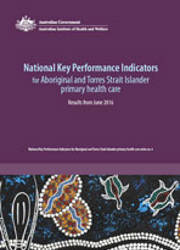Summary
This fourth national report on the Indigenous primary health care national Key Performance Indicators (nKPIs) data collection presents annual data on indicators collected from the June 2012 to the June 2016 reporting period. Data for this collection are provided to the AIHW by primary health care organisations that receive funding from the Department of Health to provide services to Aboriginal and Torres Strait Islander people. Some primary health care organisations that report receive additional funding from other sources, including state and territory health departments, while a small number are funded solely by the Northern Territory Government (see ‘Chapter 1 Introduction’).
The purpose of the nKPIs is to support policy and service planning at the national and state/territory levels, by monitoring progress and highlighting areas for improvement. The nKPIs can also be used to improve the delivery of primary health care services, by supporting continuous quality improvement (CQI) activity among service providers.
Over the period June 2012 to May 2015 (the period for which time trend data are available), improvements continue to be made across the majority of measures—indicating that health organisations continue to show progress in service provision.
The good news
Improvements were seen in 12 of the 16 process-of-care measures for which time trend data were available (Table S1). For 10 of these measures, the change was statistically significant. The largest improvements (between 16 and 19 percentage points) were seen in data recording practices for the measurement of:
- alcohol consumption, which rose from 38% in June 2012 to 57% in May 2015
- birthweight, which rose from 51% in June 2012 to 69% in May 2015
- smoking status, which rose from 64% in June 2012 to 80% in May 2015.
Results for process-of-care measures related to Medicare Benefits Schedule (MBS) health assessments (for children and adults) exceeded the 2016 trajectory of the Implementation Plan goals for the National Aboriginal and Torres Strait Islander Health Plan 2013–2023.
Improvements were also seen in 3 of the 5 health outcomes measures for which time trend data were available. For 1 of these, the change was statistically significant:
- Health of clients with type 2 diabetes—those with an HbA1c (glycosylated haemoglobin), with a result of ≤7% in the previous 6 months, rose from 32% in June 2012 to 35% in May 2015. (An HbA1c result of ≤7% is the optimum target encouraged by Diabetes Australia to ensure good glycaemic control and reduce the incidence of diabetes-related illness.)
Things to work on
Results for 3 process-of-care measures related to immunisation against influenza—clients aged 50 and over; clients with type 2 diabetes; and clients with chronic obstructive pulmonary disease (COPD)—and for the 1 process-of-care measure relating to cervical screening saw small decreases of between 1.3 and 2.6 percentage points. However, these were not statistically significant.
Results for 2 health outcome measures showed increases: the proportion of babies born with a low birthweight increased by 0.9 percentage points and people whose body mass index (BMI) score classified them as overweight or obese increased by 4.3 percentage points. However, these increases were not statistically significant. These results also remain in line with national data for Indigenous Australians.
Preliminary material: Acknowledgments; Abbreviations; Symbols
Chapter 1: Introduction
- The nKPI collection
- Changes since December 2014
- nKPI data quality
- Things to consider when interpreting nKPI data
- Clients
- Regular client definition for Northern Territory Government organisations
- Organisations contributing nKPI data
Chapter 2: Chronic disease profile
- Why is this important?
- Chronic disease profile
- Chronic disease risk factors
Chapter 3: Maternal and child health indicators
- Why are these indicators important?
- Summary of progress
Chapter 4: Preventative health indicators
- Why are these important?
- Summary of progress
Chapter 5: Chronic disease management indicators
- Why are these important?
- Summary of progress
Chapter 6: Organisations by Primary Health Networks
- Why is this important?
- Distribution of services across PHNs
Chapter 7: Progress against the Implementation Plan goals
- Why is this important?
- Summary of progress
Chapter 8: Discussion
Appendixes:
Appendix 1: Background to the nKPI collection and indicator technical specifications
Appendix 2: Data quality
Appendix 3: Comparison of nKPI results
Appendix 4: nKPI time trend results by jurisdiction and remoteness
Appendix 5: nKPI results by age group and sex
Appendix 6: Jurisdiction and remoteness variation figures
Appendix 7: Analysis of Northern Territory Government services’ data
Appendix 8: Comparison of nKPI definition results, 2015
Appendix 9: Guide to the figures
End matter: Glossary; References; List of tables; List of figures; List of boxes; Related publications



